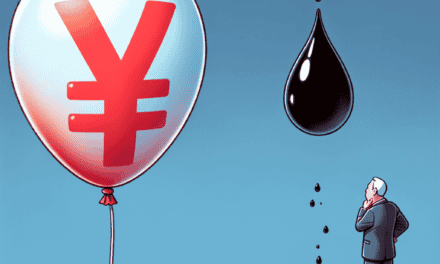“Unlocking Growth: Tech Giants Poised for a Stock-Split Surge”
Introduction
Stock splits are a strategic move by companies to make their shares more accessible to a broader range of investors by reducing the price per share while maintaining the overall market capitalization. In the fast-paced world of technology, where innovation and growth are paramount, several tech giants have seen their stock prices soar, making them prime candidates for a stock split. This article delves into three tech stocks that are currently on the radar for a potential split, examining their recent performance, market position, and the strategic benefits a split could offer. As these companies continue to expand and capture market share, a stock split could not only enhance liquidity but also attract a new wave of investors eager to participate in their growth journey.
Understanding Stock Splits: A Primer for Tech Investors
In the dynamic world of investing, stock splits often capture the attention of both seasoned investors and newcomers alike. A stock split occurs when a company increases the number of its outstanding shares, thereby reducing the price per share, while maintaining the overall market capitalization. This maneuver is often employed by companies to enhance liquidity and make their shares more accessible to a broader range of investors. As the tech sector continues to thrive, several companies are approaching price levels that may prompt them to consider a stock split. Understanding the mechanics and implications of stock splits is crucial for tech investors aiming to capitalize on these opportunities.
To begin with, it is essential to comprehend why companies opt for stock splits. Primarily, a stock split is a strategic decision aimed at improving the stock’s marketability. When a company’s share price climbs to a level that may deter smaller investors, a stock split can make the shares more affordable without altering the company’s intrinsic value. This increased accessibility can lead to a broader investor base and potentially enhance trading volume. Moreover, stock splits can signal management’s confidence in the company’s future prospects, as they often occur in the context of sustained growth and robust financial performance.
In the tech sector, where innovation and rapid growth are the norms, several companies have historically employed stock splits to maintain an optimal share price range. For instance, Apple and Tesla have executed stock splits in recent years, making their shares more attractive to retail investors. As we look ahead, there are three tech stocks that appear poised for a potential split, given their impressive performance and escalating share prices.
Firstly, consider the case of Nvidia, a leader in graphics processing units and artificial intelligence. Nvidia’s stock has experienced a remarkable ascent, driven by its dominance in the gaming industry and its expanding footprint in data centers and AI applications. As the company’s share price continues to rise, a stock split could be on the horizon to ensure that its shares remain accessible to a diverse investor base.
Similarly, Amazon, a titan in e-commerce and cloud computing, has seen its stock price soar over the years. Despite its high valuation, Amazon’s consistent innovation and expansion into new markets have sustained investor interest. A stock split could serve as a strategic move to attract more retail investors and maintain liquidity, especially as the company continues to explore new growth avenues.
Lastly, Alphabet, the parent company of Google, is another tech giant that may consider a stock split. With its shares trading at elevated levels, a split could enhance the stock’s appeal to a wider audience. Alphabet’s strong financial performance, driven by its dominance in digital advertising and its ventures into artificial intelligence and cloud services, positions it as a prime candidate for a stock split.
In conclusion, while stock splits do not alter the fundamental value of a company, they can have significant psychological and practical effects on investor behavior. For tech investors, staying informed about potential stock splits is a prudent strategy, as these events can influence market dynamics and present unique investment opportunities. As Nvidia, Amazon, and Alphabet continue to excel in their respective domains, their stock prices may soon reach thresholds that make a split not only beneficial but also strategically advantageous. Understanding the nuances of stock splits can empower investors to make informed decisions in the ever-evolving tech landscape.
Historical Impact of Stock Splits on Tech Companies
Stock splits have long been a strategic tool employed by companies to enhance the liquidity and accessibility of their shares. In the technology sector, where stock prices can soar rapidly due to innovation and market demand, stock splits have historically played a significant role in maintaining investor interest and participation. By examining the historical impact of stock splits on tech companies, we can gain insights into how such corporate actions have influenced market dynamics and investor behavior.
To begin with, stock splits are often perceived as a positive signal by the market, suggesting that a company is confident in its future growth prospects. This perception is particularly relevant in the tech industry, where rapid advancements and disruptive innovations can lead to substantial increases in stock prices. For instance, when a tech company announces a stock split, it often indicates that the company has experienced significant appreciation in its stock value, making it less affordable for average investors. By splitting the stock, the company effectively lowers the price per share, thereby broadening its investor base and enhancing liquidity.
Historically, tech companies that have executed stock splits have often witnessed a favorable market response. A notable example is Apple Inc., which has executed multiple stock splits over the years. Each split was followed by a period of increased trading volume and, in many cases, a subsequent rise in the stock price. This pattern can be attributed to the psychological effect on investors, who perceive the lower price as an opportunity to invest in a high-quality company at a more accessible price point. Moreover, the increased liquidity resulting from a stock split can lead to tighter bid-ask spreads, further encouraging trading activity.
Similarly, companies like Microsoft and NVIDIA have also benefited from stock splits. Microsoft’s stock split history is marked by several splits during its early growth phase, which helped maintain investor interest and facilitated the stock’s inclusion in various investment portfolios. NVIDIA, on the other hand, executed a stock split in 2021, which was well-received by the market, reflecting investor confidence in the company’s long-term growth trajectory. These examples underscore the potential benefits of stock splits in enhancing market perception and driving investor engagement.
However, it is important to note that while stock splits can have positive short-term effects, they do not inherently alter the fundamental value of a company. The intrinsic value remains unchanged, as the split merely adjusts the number of shares outstanding and the corresponding price per share. Therefore, investors should consider stock splits as part of a broader investment strategy, focusing on the underlying business fundamentals and growth prospects.
In conclusion, the historical impact of stock splits on tech companies highlights their role as a strategic tool for enhancing market accessibility and liquidity. By making shares more affordable and appealing to a wider range of investors, stock splits can foster increased trading activity and positive market sentiment. As we observe the current landscape, several tech stocks appear poised for potential splits, driven by their impressive growth trajectories and rising stock prices. While the decision to split ultimately rests with the company’s management, the historical precedent suggests that such actions could yield favorable outcomes for both the company and its investors. As always, investors should remain vigilant, considering both the opportunities and limitations presented by stock splits within the broader context of their investment objectives.
Analyzing Market Trends: Why Tech Stocks Opt for Splits
In the ever-evolving landscape of the stock market, stock splits have emerged as a strategic maneuver employed by companies to enhance liquidity and make their shares more accessible to a broader range of investors. This practice, particularly prevalent in the technology sector, has garnered significant attention as tech giants continue to experience substantial growth. As we delve into the intricacies of stock splits, it becomes evident that several tech stocks are poised for such a move, driven by their impressive performance and market dynamics.
To begin with, stock splits are primarily executed to reduce the trading price of a company’s shares, thereby making them more affordable for retail investors. This increased accessibility often leads to a broader shareholder base and enhanced liquidity, which can be advantageous for both the company and its investors. In the technology sector, where innovation and rapid growth are the norms, stock splits can serve as a signal of confidence in a company’s future prospects. As tech companies continue to expand their market presence and achieve remarkable financial milestones, the likelihood of stock splits becomes increasingly probable.
One such company that appears ready for a stock split is Apple Inc. With its consistent track record of innovation and market leadership, Apple has seen its stock price soar over the years. The company’s robust financial performance, driven by strong sales of its flagship products and services, has resulted in a significant appreciation of its stock value. Consequently, a stock split could be on the horizon as Apple seeks to maintain its appeal to a diverse range of investors. By making its shares more affordable, Apple could further solidify its position as a dominant player in the tech industry.
Similarly, Amazon.com Inc. is another tech giant that seems poised for a stock split. The e-commerce behemoth has experienced exponential growth, fueled by its relentless focus on customer satisfaction and continuous expansion into new markets. As Amazon’s stock price continues to climb, a stock split could be a strategic move to attract more retail investors and enhance liquidity. This would not only democratize access to Amazon’s shares but also potentially drive further investment in the company, supporting its ambitious growth plans.
Moreover, Alphabet Inc., the parent company of Google, is also a strong candidate for a stock split. Alphabet’s diverse portfolio, encompassing search, advertising, cloud computing, and various other ventures, has positioned it as a formidable force in the tech sector. The company’s impressive financial performance and strategic investments have led to a substantial increase in its stock price. A stock split could serve as a catalyst for Alphabet to broaden its investor base and maintain its competitive edge in the rapidly evolving technology landscape.
In conclusion, the prospect of stock splits among tech companies like Apple, Amazon, and Alphabet underscores the dynamic nature of the technology sector. As these companies continue to innovate and expand, stock splits offer a mechanism to enhance accessibility and liquidity, benefiting both the companies and their investors. By making their shares more affordable, these tech giants can attract a wider range of investors, thereby reinforcing their market positions and supporting their long-term growth trajectories. As we keep a close watch on these developments, it is clear that stock splits remain a vital tool in the strategic arsenal of leading tech companies, reflecting their confidence in sustained growth and market leadership.
Predicting the Next Big Tech Stock Split: Key Indicators

In the ever-evolving landscape of the stock market, stock splits have long been a strategic tool employed by companies to enhance liquidity and make their shares more accessible to a broader range of investors. As we turn our attention to the tech sector, a realm characterized by rapid growth and innovation, several companies appear poised for potential stock splits. Understanding the key indicators that suggest a stock split is imminent can provide investors with valuable insights into future market movements.
Firstly, one of the primary indicators of a potential stock split is a significant increase in a company’s stock price. When a stock’s price becomes prohibitively high, it can deter smaller investors from purchasing shares, thereby reducing market liquidity. In the tech sector, where companies often experience exponential growth, this scenario is not uncommon. For instance, when a tech giant’s stock price soars into the hundreds or even thousands of dollars per share, a stock split can make the shares more affordable and attractive to a wider audience. This democratization of share ownership can lead to increased trading volume and, consequently, greater market capitalization.
Moreover, another key indicator is the company’s historical precedent regarding stock splits. Companies with a history of splitting their stock are more likely to do so again, especially if they have experienced substantial growth since their last split. By examining past behavior, investors can gauge the likelihood of a future split. For example, if a tech company has consistently split its stock every time it reached a certain price threshold, it is reasonable to anticipate a similar action when that threshold is approached again.
Additionally, the company’s growth trajectory and market position play a crucial role in predicting stock splits. Tech companies that are leaders in their respective fields and exhibit strong growth potential are prime candidates for stock splits. These companies often have robust financials, a solid customer base, and innovative products or services that drive their stock prices upward. As they continue to expand and capture market share, a stock split can be a strategic move to maintain momentum and investor interest.
Furthermore, investor sentiment and market conditions can also influence the likelihood of a stock split. In bullish markets, where investor confidence is high, companies may be more inclined to split their stock to capitalize on positive sentiment and attract new investors. Conversely, in bearish markets, companies might delay a split to avoid potential volatility. Therefore, keeping an eye on broader market trends and investor sentiment can provide additional context when assessing the probability of a stock split.
In conclusion, while predicting the exact timing of a stock split can be challenging, several key indicators can offer valuable clues. A significant increase in stock price, historical precedent, strong growth trajectory, and favorable market conditions all contribute to the likelihood of a stock split. As we observe the tech sector, companies that exhibit these characteristics are well-positioned for potential splits. By staying informed and vigilant, investors can better navigate the dynamic world of tech stocks and capitalize on the opportunities that stock splits present.
Investor Reactions to Tech Stock Splits: A Case Study
In recent years, stock splits have become a notable event in the financial markets, particularly within the technology sector. These corporate actions, which involve dividing a company’s existing shares into multiple ones, often aim to make the stock more accessible to a broader range of investors. As we examine investor reactions to tech stock splits, it is essential to consider the underlying reasons for these splits and their subsequent impact on market perception and stock performance.
Historically, stock splits have been perceived as a positive signal by investors, suggesting that a company is confident in its future growth prospects. This perception is often reflected in the immediate uptick in stock prices following the announcement of a split. For instance, when a tech giant like Apple or Tesla announces a stock split, it typically generates significant media attention and investor interest. This heightened attention can lead to increased trading volumes and, in many cases, a temporary boost in the stock’s market value.
One of the primary reasons tech companies opt for stock splits is to enhance liquidity. By increasing the number of shares available, companies can make their stocks more affordable for retail investors. This democratization of stock ownership can lead to a more diverse shareholder base, which is often viewed favorably by the market. Moreover, a lower share price can attract new investors who may have been previously deterred by a high price tag, thereby broadening the investor pool and potentially stabilizing the stock’s price over time.
Another factor contributing to the positive investor reaction is the psychological aspect of stock splits. Many investors perceive a split as an indication of a company’s robust financial health and strong future performance. This perception can create a self-fulfilling prophecy, where the increased demand for the stock post-split drives up its price, reinforcing the belief in the company’s growth trajectory. However, it is crucial to note that a stock split does not inherently alter a company’s market capitalization or its fundamental value. Instead, it is a strategic move to enhance the stock’s marketability and accessibility.
In analyzing recent case studies, it becomes evident that tech stocks often experience a surge in investor interest following a split announcement. For example, when Alphabet, the parent company of Google, announced its stock split, the market responded with enthusiasm, leading to a notable increase in trading activity. Similarly, Nvidia’s stock split announcement was met with a positive reception, as investors anticipated continued growth in the semiconductor industry.
Despite the generally favorable reaction to stock splits, investors should exercise caution and conduct thorough due diligence. While a split can make a stock more attractive in the short term, it is essential to evaluate the company’s long-term prospects and industry position. Factors such as competitive advantage, innovation pipeline, and financial health should be considered when assessing the potential impact of a stock split on a company’s future performance.
In conclusion, stock splits in the tech sector often generate positive investor reactions, driven by increased accessibility, enhanced liquidity, and psychological factors. However, while these events can create short-term market excitement, investors should remain focused on the underlying fundamentals of the company. By doing so, they can make informed decisions that align with their long-term investment strategies, ensuring that they capitalize on opportunities presented by stock splits while mitigating potential risks.
The Financial Mechanics Behind Tech Stock Splits
In the dynamic world of technology stocks, the phenomenon of stock splits often captures the attention of investors and market analysts alike. A stock split, fundamentally, is a corporate action in which a company divides its existing shares into multiple shares to boost the liquidity of the shares. While the total dollar value of the shares remains unchanged, the number of shares outstanding increases, making the stock more accessible to a broader range of investors. This financial maneuver is particularly prevalent in the tech sector, where rapid growth can lead to soaring stock prices. As we delve into the financial mechanics behind tech stock splits, it becomes evident that certain tech stocks are poised for such a strategic move.
To begin with, stock splits are often employed by companies whose share prices have risen to levels that might be perceived as too high for average investors. By splitting the stock, companies can make their shares more affordable and attractive, thereby potentially increasing the stock’s marketability and liquidity. This is particularly relevant in the tech industry, where innovation and growth can lead to significant appreciation in stock prices. For instance, when a tech company experiences substantial growth due to successful product launches or market expansion, its stock price may rise to a point where a split becomes a viable option to maintain investor interest and participation.
Moreover, stock splits can signal a company’s confidence in its future prospects. When a tech company decides to split its stock, it often indicates that the company anticipates continued growth and profitability. This can be a positive signal to investors, suggesting that the company is on a strong upward trajectory. In the tech sector, where competition is fierce and innovation is constant, such signals can be crucial in maintaining investor confidence and attracting new capital.
Currently, there are several tech stocks that appear ready for a split. These companies have experienced significant growth, resulting in high stock prices that could benefit from a split. For example, a leading tech giant known for its innovative consumer electronics and software solutions has seen its stock price climb steadily over the past few years. With a robust product pipeline and a strong market position, a stock split could enhance its appeal to a wider range of investors.
Similarly, another prominent player in the cloud computing and artificial intelligence space has witnessed remarkable growth, driven by increasing demand for its services. As its stock price continues to rise, a split could serve to make its shares more accessible, thereby broadening its investor base and enhancing liquidity.
Lastly, a well-known social media platform, which has expanded its user base and advertising revenue significantly, also appears ripe for a stock split. With its stock price reaching new heights, a split could help maintain its momentum by attracting more retail investors.
In conclusion, the financial mechanics behind tech stock splits reveal a strategic approach to managing high stock prices and enhancing marketability. By making shares more affordable and signaling confidence in future growth, stock splits can play a pivotal role in a company’s financial strategy. As we observe the current landscape, it is clear that certain tech stocks are well-positioned for a split, potentially setting the stage for continued success and investor engagement in the ever-evolving tech sector.
Future Outlook: How Stock Splits Could Shape the Tech Sector
In the ever-evolving landscape of the technology sector, stock splits have emerged as a strategic maneuver that companies employ to enhance liquidity and make their shares more accessible to a broader range of investors. As we look to the future, several tech giants appear poised to consider stock splits, a move that could significantly influence the dynamics of the market. Understanding the potential impact of these stock splits requires a closer examination of the companies likely to undertake such actions and the broader implications for the tech sector.
Firstly, it is essential to recognize that stock splits do not inherently alter the fundamental value of a company. Instead, they adjust the share price and the number of shares outstanding, making the stock more affordable for retail investors. This increased accessibility can lead to a broader investor base and potentially higher trading volumes. In the tech sector, where innovation and rapid growth are paramount, stock splits can serve as a signal of confidence from management, indicating that they anticipate continued growth and wish to attract a diverse group of investors.
One company that appears ready for a stock split is Alphabet Inc., the parent company of Google. With its shares trading at high levels, a stock split could make Alphabet’s stock more attractive to individual investors. This move would not only democratize access to one of the most influential tech companies but also potentially increase liquidity. As Alphabet continues to expand its ventures into artificial intelligence, cloud computing, and autonomous vehicles, a stock split could further bolster investor interest and support its ambitious growth trajectory.
Similarly, Amazon.com Inc. is another tech behemoth that could benefit from a stock split. Historically, Amazon has refrained from splitting its stock, even as its share price has soared. However, with increasing competition in e-commerce and cloud services, a stock split could be a strategic move to maintain its competitive edge. By making its shares more affordable, Amazon could attract a new wave of investors eager to participate in its continued dominance in the tech sector. Moreover, a stock split could enhance Amazon’s appeal to employees, as stock-based compensation becomes more tangible and rewarding.
Another contender for a potential stock split is Tesla Inc., a company that has already executed stock splits in the past. Tesla’s rapid growth and high share price make it a prime candidate for another split. As the electric vehicle market continues to expand, a stock split could reinforce Tesla’s position as a leader in the industry. By lowering the share price, Tesla could attract a broader investor base, fueling further investment in its innovative projects, such as energy storage solutions and autonomous driving technology.
In conclusion, the prospect of stock splits among major tech companies like Alphabet, Amazon, and Tesla holds significant implications for the future of the tech sector. These potential splits could democratize access to high-performing stocks, increase liquidity, and attract a diverse range of investors. As these companies continue to innovate and expand, stock splits could serve as a catalyst for sustained growth and market influence. While stock splits do not change the intrinsic value of a company, their impact on investor perception and market dynamics cannot be underestimated. As we look ahead, the tech sector’s landscape may be reshaped by these strategic financial decisions, underscoring the importance of stock splits in the broader context of market evolution.
Q&A
1. **Question:** What is a stock split?
**Answer:** A stock split is a corporate action in which a company divides its existing shares into multiple shares to boost the liquidity of the shares.
2. **Question:** Why might a tech company consider a stock split?
**Answer:** A tech company might consider a stock split to make its shares more affordable to a broader range of investors and to increase liquidity.
3. **Question:** Which tech company recently completed a stock split?
**Answer:** Apple Inc. recently completed a stock split, executing a 4-for-1 split in August 2020.
4. **Question:** What is one potential benefit of a stock split for existing shareholders?
**Answer:** One potential benefit for existing shareholders is that the increased number of shares can lead to greater marketability and potentially higher demand, which might positively impact the stock price.
5. **Question:** How does a stock split affect the market capitalization of a company?
**Answer:** A stock split does not affect the market capitalization of a company; it only increases the number of shares while reducing the price per share proportionally.
6. **Question:** Name a tech stock that is considered a candidate for a future stock split.
**Answer:** Alphabet Inc. (Google’s parent company) is often considered a candidate for a future stock split due to its high share price.
7. **Question:** What is a reverse stock split, and how does it differ from a regular stock split?
**Answer:** A reverse stock split is a corporate action in which a company reduces the number of its outstanding shares, increasing the share price proportionally. It differs from a regular stock split, which increases the number of shares and decreases the share price.
Conclusion
In conclusion, the anticipation of stock splits for certain tech companies can generate significant investor interest and potentially impact stock performance. Companies that are likely candidates for stock splits often exhibit strong financial health, robust growth prospects, and high share prices. By splitting their stocks, these companies aim to enhance liquidity, make shares more accessible to a broader range of investors, and maintain momentum in their market valuation. Investors should closely monitor these tech stocks for any announcements, as stock splits can serve as a positive signal of confidence from management and may lead to increased market activity and investor engagement.





